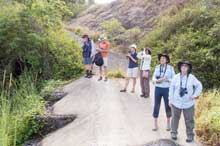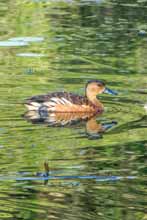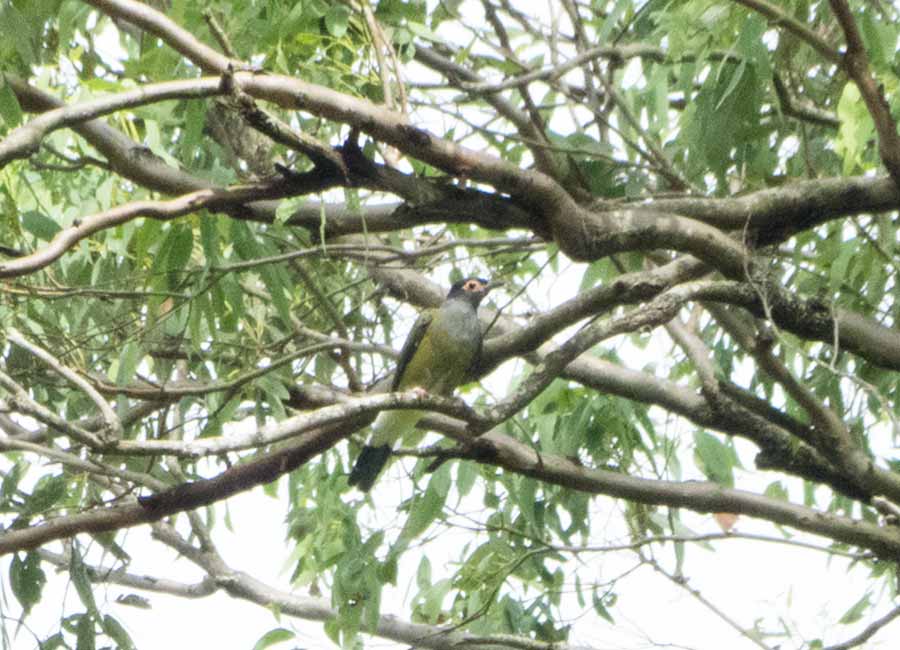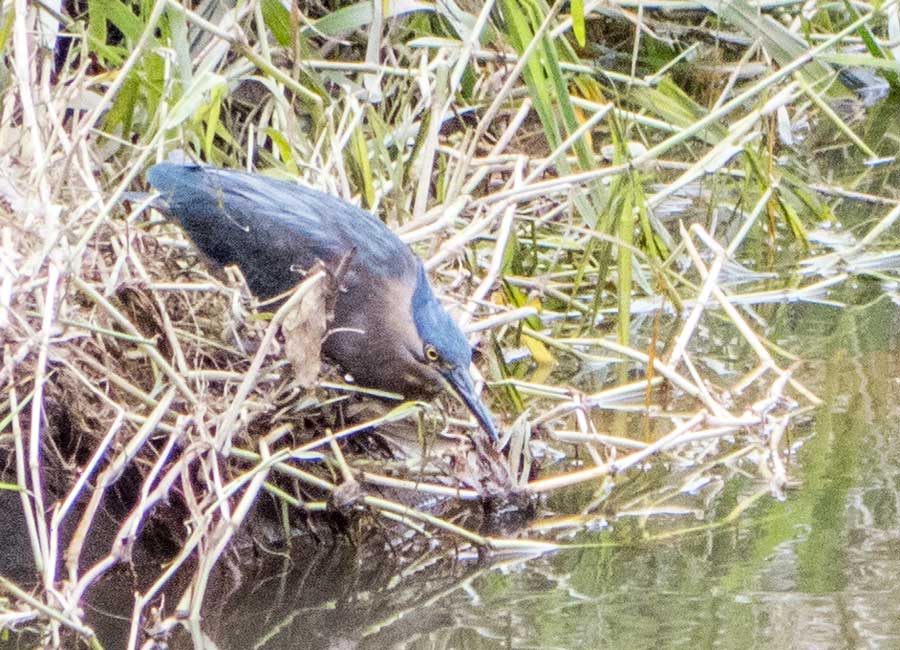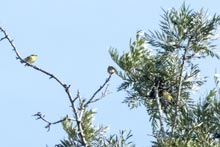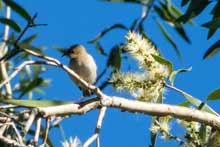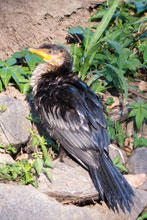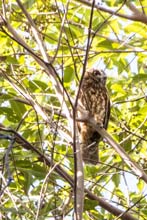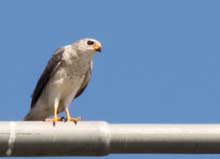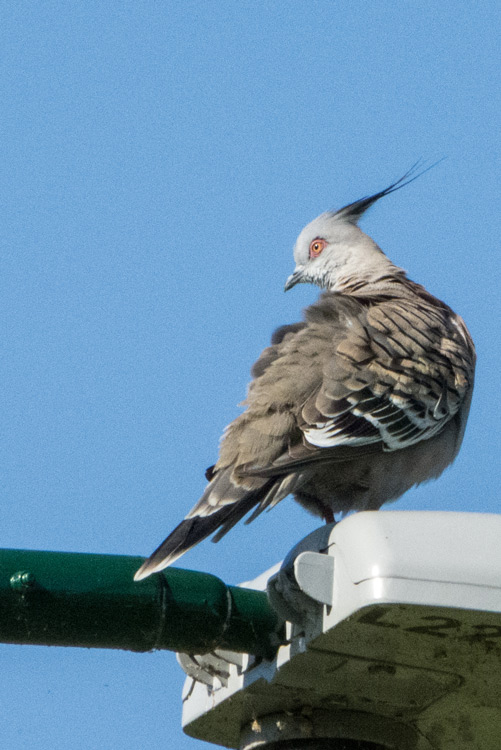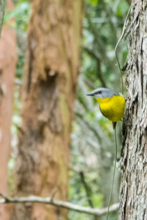were found over the hour and a half of birding conducted this morning (4 December 2016)
Survey precautions
Links to Home and to other years
General details of 2017 observations
Detailed results for 2017
Contact
Background
This first page will be used to outline the general manner in which these bird walks are conducted, observations made and their recording. Since 2008, at least ten bird walks have been conducted each year in set locations selected as being representative of bird habitats along Kedron Brook.
Cedar Creek from a concrete bridge
at Upper Kedron (4 December 2016)
For convenience, those records of observations during walks for the current year are being accumulated at first on this introductory page. At the end of each year, the results will be moved to a specific page for that year together with any tabular results and images. A link bar on each page allows an easy shift between the pages for each year and back to this introductory page that includes the results for the current year to date. A click on each picture leads to a larger image!
This project aims to accumulate data on bird life along the Brook, specifically those variations in birds species noted together with their distribution. A similar program has been set up each year but it is based upon a randomization of the actual sequence of the locations to be visited over the year. This step is to minimise any seasonal effects on the number and type of birds species to be found at a particular location. The apparent absence of a particular species of bird at such a location for one or so years may possibly be explained by a migration influence.
Although we have a number of catchment members that are experienced birders, the leadership of Dawn Muir, supported by Esther Townsend (both experienced birders within Birds Queensland) has been vital. Their contributions to the success of this project have been most appreciated.
The program for 2017 is available now. Interested persons should also check the latest news in the home page project section to keep
up to date on the next walk and possible changes due to poor weather or leadership availability.
General precautions to be used during these observations
These outings need to be carried out in a rather small group to reduce disturbance of, often, quiet elusive birds. It takes members of reasonable experience to be able to observe and identify birds correctly. However, there has been the occasional opportunity for a new keen birder to join and learn the ropes on most of our outings. Please check with our Outing Coordinator in the Contact section below for further information.
Birders should bring their own personal food and water requirements and sun and skin protection (sunscreen and insect repellent). Although most outings are conducted along made paths, sometimes it is necessary to move carefully into bushland to more closely observe bird movements. Clothes and footwear should be chosen to suit these conditions, where possible. Travelling through natural flora and fauna habitats is usually of relatively low risk (compared with the risk of crossing busy roads) but skin irritations from harmful plants or tick bites can occasionally concern sensitive individuals.
Links to Home and to other years
General details of 2017 observations to date
Most images will enlarge to a more suitable size if a left-click is made on top of the image. Details of the locations and general arrangements for each walk are available in the yearly programs. Link to the program for 2017 here.
Nudgee Waterhole, Nudgee Wharf and Beach - 5 February 2017
At our first birding for 2017 we welcomed newcomers, Josh and Barb, and also Anne's sister Ellen, visiting from the Daintree. It was a pleasant start to the morning, but much heat was promised later in the day.
seen at Bellbird Grove, D'Aguilar
National Park. (5 March 2017)
There was great excitement when we first met at the waterhole to see a Wandering Whistling Duck; the first sighting for most of us. The great thing about waterbirds is that they tend to stay in the same place and give everyone the opportunity of a good sighting. Also at the waterhole were Darters (including one on a nest), Little Pied Cormorants, Little Black Cormorants, an Intermediate Egret, a Little Egret and a Cattle Egret as well as Dusky Moorhens, Eurasian Coots and Purple Swamphens. A total of forty-nine species were observed (at the Waterhole, Nudgee Boat Ramp and Nudgee Beach combined).
Excessive traffic at the beach forced us to park a block away from our usual parking place - but with great rewards. The tide was well out and we were able to venture through the mangroves in search of waders. A first for our group (in this location) was a Pacific Golden Plover (more sighted later towards the dog off-lead area), a Bar-tailed Godwit and in the mangroves themselves, four Collared Kingfishers. An excellent morning's birding indeed.
Bellbird Grove, Brisbane Forest Park - 5 March 2017
Eight members met at Bellbird Grove on a cool and cloudy morning. We were saddened to see the Brush Turkeys turning over some rubbish left by a thoughtless polluter. Then we saw a Bush Stone_curlew join in and picking amongst the rubbish. Mary kindly cleared up the rubbish before leaving at the end of our walk.
A total of 33 species were seen, with much interest given to the relatively large number of Varied Trillers, Brown Thornbills and White-throated Treecreepers. Eastern Yellow Robins were present along with Large-billed Scrubwrens and White-browed Scrubwrens. Of particular concern was the development of roads being pushed around the dam area on an adjoining private property; particularly as there were at least two fences dropped down leading directly into the adjacent National Park.
Kalinga Park - Cressey St. Wetlands - 2 April 2017
Eight enthusiasts gathered in the carpark on a fine sunny morning; three days after the remnant Cyclone Debbie passed through the area.
Kalinga Park and its surrounds had had some extensive flooding and suffered from the strong winds of Thursday, 30th March. Most noticeable was the absence of small birds, wrens and honeyeaters. However, a count of forty-three species for the area was quite a respectable number given the aforementioned conditions.
Cedar Creek - 7 May 2017
A fine sunny but cool morning set the scene at our starting area at Nelson Place, Ferny Grove. Despite the fine sunny weather there
was only a total of thirty-six species observed on this morning. This may have been influenced by a steady reduction of the forest area about this location.
Nevertheless, the well-watered creek area at this point attracts most of the common birds from along the Kedron Brook. Striated Pardalotes have always been a consistent species, Honeyeaters are well distributed within the area and the Eastern Whipbird cracks its whip within the thicker scrub close to the creek south of Upper Kedron Road. Another welcome call was that of a juvenile OIlive-backed Oriole practising its calls.
Bob Cassimaty, Thomsett and Arbor Parks - 4 June 2017
We gathered on a fairly cool clear morning in the car park at Cassimarty Park, Ferny Grove. Opposite on a dead tree a pair of Galahs with bright pink chests were just catching the first of the morning sun and positively glowed. Although species numbers were somewhat down on previous surveys, it may be that the time of the year and the fairly cold conditions prevailing was the cause.
However, we had great interest in the large number of Scarlet Honeyeaters seen flitting between two flowering paperbarks in Arbor Park.
Pony Club Bend, Mitchelton and Teralba Park - 2 July 2017
Six brave souls nearly froze before the start of the walk but then gradually warmed as they walked under the rays of sun fighting away the clouds. We walked the usual track but didn’t go all the way along close to the creek as it was heavily overgrown and the long grass was very wet with dew. A meagre twenty-five birds were counted during the morning; mainly the regular park birds and smaller birds such as the honeyeaters.
The brook has changed its course considerably in places with lots of gravel washed into it with the last floods. However, there’s been some new plantings along the Osborne Road section and heaps of bark mulch are awaiting spreading. A generous sized garden bed of bush plants is being prepared in front of the mosaic chair along to and past the steps down to the brook.
Grinstead Park and Sparkes Hill Reserve - 6 August 2017
It was overcast and cold at first at Grinstead Park, but gradually it warmed up for our six attendees and it was sunny throughout the visit to Sparkes Hill Reserve. We ended up with a satisfying record of forty-five species spread between the two areas visited.
Our catchment bushcare group members have seen night owls reported over the years but this was the first time that a Southern Boobook was sighted within this programmed series of observations. Despite the bright lighting, we still found it rather difficult to see one owl camouflaged high in the leafy tops of Sparkes Hill Reserve forest. On the other hand, a huge flock of Scarlet Honeyeaters took over the entrance section of the forest entrance showing off their brilliant red colouring; particularly by the males.
Zion Hill, Nundah, and Kedron Brook Wetlands - 3 September 2017
It was a fine, warm, sunny morning for our eight attendees. We ended up with a satisfying record of forty-nine species spread over the areas visited.
A large flock of Great Comorants flew overhead on our way through Albert Bishop Park towards the Kedron Brook Wetlands. This was a first time for us during our formal catchment surveys conducted since 2008. Likewise, we had a close look at the only raptor seen; a Black-shouldered Kite searching for prey close to Nundah Lake.
Grange Forest Park - 8 October 2017
An enthusiastic group of fourteen birders gathered on a fine, somewhat cloudy, morning for this survey. A total of forty-five species were seen.
All three common types of Fairy-wrens were sighted as well as Tawny Grassbirds, many Australian Reed Warblers, and Silvereyes. We all enjoyed the sighting of Mr. and Mrs. Pacific Black Duck with their brood of little ducklings. It was good to have found such a variety of small birds in the survey; possibly the recent rains had rejuvenated them and their habitats.
Over recent years, there has been an an up-to-date classification of Australian birds carried out in relation to their taxonomic units. At least a dozen have been found to be considered to be in a new order and continued studies no doubt will justify more changes with time. For example, the Pacific Black Duck has now been renamed 'Maned Duck'. The Australian Reed Warbler was originally classified as being included as part of the Clamourous Reed Warbler (Acrocephalus stentorius) section of the Old World warblers, but is now considered to be a separate species (Acrocephalus australis).
Wahminda Grove and Maureen Lawrence Park - 5 November 2017
Eight birders set off on a fine, though warm, morning with cloud developing. A welcome total of forty-three species were seen or heard.
In addition to the maintenance activities conducted on public land, the local Wahminda Grove Bushcare Group is also responsible for a large bushland restoration project funded by Powerlink on the unusable portion of their Ferny Hills sub-station site. It was very gratifying to find the upper pathway adjoining this area was suitably slashed along the Wahminda Grove perimeter. This allowed us safe access to the adjoining bushland without disturbing the actual habitat of groups of the smaller birds.
We enjoyed the sight of an Eastern Yellow Robin whacking a caterpiller for its breakfast; closely watched on by two of its mates. Also in Maureen Lawrence Park, we saw a pair of Spangled Drongos building their nest. Then, as we leasurely strolled back to our cars, a pair of Eastern Whipbirds
raced across the path in front of us giving everyone a good sighting.
Detailed results for 2017
Results of birds observed on each walk may be linked from this table as the outcomes of any completed studies for this year become available.
| Date | Link to | Description |
|---|---|---|
| 05/02/2017 | pdf file | Nudgee Waterhole Reserve through to Nudgee Beach |
| 05/03/2017 | pdf file | Bellbird Grove, Brisbane Forest Park |
| 02/04/2017 | pdf file | Kalinga Park - Cressey St. Wetlands |
| 07/05/2017 | pdf file | Cedar Creek, Upper Kedron |
| 04/06/2017 | pdf file | Bob Cassimaty, Thomsett and Arbor Parks, Ferny Grove |
| 02/07/2017 | pdf file | Pony Club Bend, Mitchelton, and Teralba Park |
| 06/08/2017 | pdf file | Grinstead Park and Sparkes Hill Reserve |
| 03/09/2017 | pdf file | Zion Hill, Nundah, and Kedron Brook Wetlands (birds over 6 years period) |
| 08/10/2017 | pdf file | Grange Forest Park |
| 05/11/2017 | pdf file | Wahminda Grove - Maureen Lawrence Park |
Additional walks
Occasionally, we go birding outside our normal set areas along the Kedron Brook Catchment. See this section on the 2015 page for past records here.
During a late afternoon walk along Cedar Creek at Upper Kedron on 22 February 2016, a pair of Brown Cuckoo-Doves were observed. This was the first time since the start of our casual walks in this area from 2015.
Contact
Bird lovers are always welcome on our walks but note the special precautions above to ensure happy birding. Factors such as weather and availability of leadership mean that some outings may need to be changed at relatively short notice. Please contact Outing Coordinator, Jenny Ivin, on phone 3851 0160 or for further information.
CI 05/11/2017


